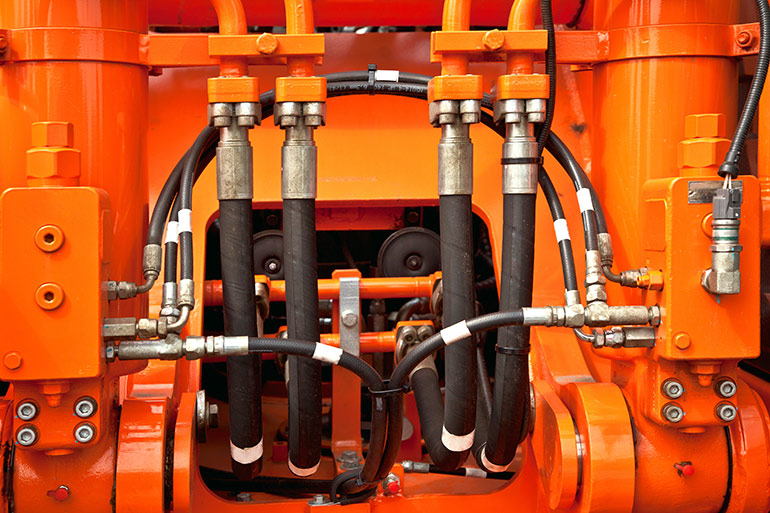By Joe Carr, product manager, specialty fittings, Brennan Industries, Inc.
In the pursuit of industrial progress, companies are seeking innovation that extends to inconspicuous components like hydraulic fittings and flanges. Operating discreetly in the background, these parts take a crucial role in propelling industries forward. Hydraulic components are essential to machinery, directing high-pressure fluid flows for tasks like powering production lines and controlling aircraft.

Despite their size, hose fittings and flanges aren’t immune to potential risks, such as system failures and diminished performance caused by minor leaks or bends. Therefore, it’s important to recognize that these components have significant influence, enhancing the precision, accuracy and reliability of hydraulic systems. This article discusses the importance of quality hydraulic fittings and flanges, unraveling their impact on innovation and advancements across industries.
Quality hydraulic components matter
Increasing durability, resisting leakage and ensuring reliable hydraulic system performance requires proactive measures. Small leaks in hose fittings and flanges can have detrimental effects on performance, leading to catastrophic system failures. In response, top manufacturers are continually advancing materials science and machining processes to enhance durability and resistance to high hydraulic pressures and harsh temperatures. These manufacturers focus on eliminating potential weaknesses or defects that may cause leakage, component wear and compromise safety or reliability in industrial equipment, off-road machinery and transportation systems. By maintaining the integrity of each sealing component, they not only enhance machinery performance but also effectively reduce the risk of contamination, ensuring a cleaner and more reliable operation.
New in-line measurements for contaminant monitoring
Hydraulics has undergone a transformation in recent years, transitioning from offline to online methods for contaminant monitoring. Manufacturers are currently dedicated to creating specialized instruments for in-line measurements, allowing for the execution and classification of contamination levels in accordance with ISO 4406 and NAS1638 standards. Additionally, the new method incorporates tools for measuring and monitoring saturated water in oil, laboratory particle counting and detecting/counting metal particles.
Utilizing these measurement methods enables the continuous inspection and diagnosis of hydraulic systems. This is particularly important for large gears and lubrication systems, facilitating wear surveillance and early identification of potential damage.
Hydraulic system longevity
The operational lifespan of hydraulic systems and components can be decreased due to various factors. Thus, it is essential to identify and consistently uphold an optimal fluid cleanliness level to avert contamination from particles, water or gas. After establishing the minimum cleanliness requirement for a specific part of the system’s lifespan, you can then actively monitor fluid cleanliness. This ensures the continuous maintenance of the desired cleanliness level.
Measuring contamination
Methods for measuring contamination provide both fixed and mobile particle counting and fluid monitoring. Every diagnosis is made promptly and accurately in accordance with current guidelines. A vital part of a comprehensive maintenance strategy includes various products for measuring particle pollution. These methods are designed for online applications and offline and in-line operations.
The equipment incorporates in-line measuring instruments, conducting measurements within the device itself. Additionally, offline devices are positioned externally while being disconnected from the machine. Lastly, there are online systems situated outside the machine, immediately linked to the equipment and its control interfaces.
Through an Excel-based data manager, operators may manage data and control operations with any of the three configurations capable of connecting to external PCs. The decision between online, offline and in-line methods is influenced by several elements, including production flow limitations, data processing requirements and measurement speed. Each has different benefits based on how it is used.
Sustainability through precision engineering
Efficient hydraulic systems not only have broad environmental implications but also play a role in resource conservation. Leaking fittings pose threats of resource depletion and hazardous spills, thereby creating safety risks. Engineers can contribute to long-term energy and cost savings by optimizing the quality of hydraulic fittings and flanges.
In response to growing concerns about climate change, some manufacturers are adopting eco-friendly practices, incorporating recycled polymers and cleaner chemicals into hoses and seals. The exceptional sealing capabilities of precision-machined flanges prevent fluid leaks, while their environmentally conscious construction minimizes industrial waste.
Even minor adjustments to standard flanges and fittings can revolutionize sustainability. This highlights how the efficiency gained through precise engineering extends beyond enhancing machine performance. Small dimensional improvements in flanges and fittings significantly impact productivity, safety and sustainability. As a result, professionals in the field consistently work towards refining machining processes and advancing materials science, acknowledging that even subtle changes can yield great effects.
The hydraulic components supply chain
Advancements in components offer limited value if suppliers cannot consistently deliver them to equipment OEMs and maintenance teams. To enhance the procurement experience, distributors often provide value-added services, such as custom hose assembly, kitting and fluid samples.
In turn, manufacturers provide product knowledge, standards and procedures to distributor sales teams. The result is the availability of critical components precisely when and where they are required, thanks to the mutually advantageous partnerships between distributors and manufacturers. To fortify these collaborations, manufacturers are introducing additional service-oriented solutions.
Conclusion
Although improvements in hydraulic flanges and fittings may appear minor, they have a significant effect across industrial, construction, agricultural and transportation equipment. Brennan Industries is well known for its quality fittings and flanges. The company’s techniques produce resilient, seamless fittings backed by aerospace-level quality control and extensive material and coating options. Brennan offers complete tracking on all components and maintains certifications worldwide. This dedication to continuous improvement creates fittings and flanges with enhanced quality that thrive under extreme pressures across diverse applications.
The future will bring advanced fittings and flanges that further heighten performance and efficiency. However, there will also be a stronger focus on the surrounding system, ensuring that parts work together and spread evenly. Even while improvements to single flanges and fittings might not seem like much, they are essential for hydraulic systems and industries. Relentlessly improving these components can increase productivity, sustainability, quality and reduce contamination.
Filed Under: Components Oil Coolers, Fittings, Couplings & Adapters, Hose Assembly Tips, Technologies